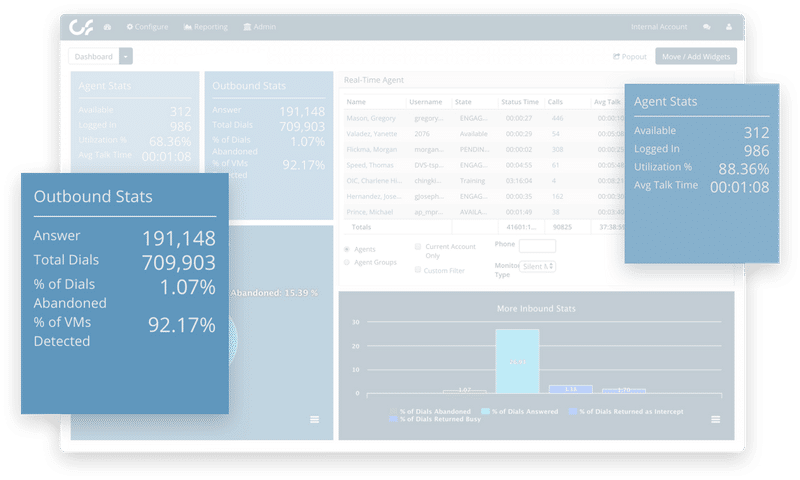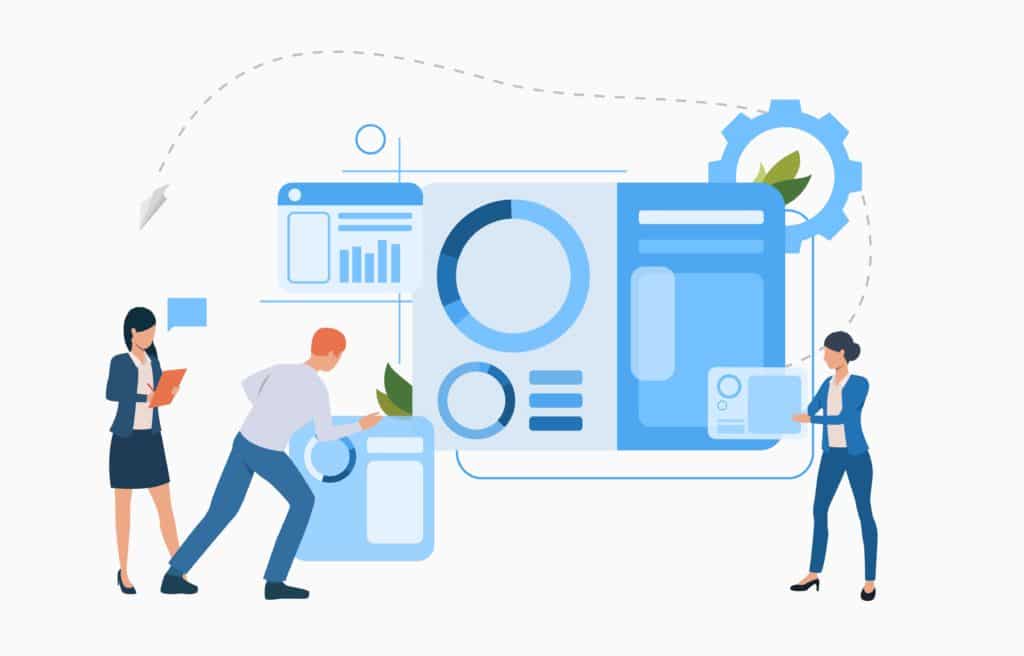When it comes to contact center software, change is always a moment away. Whether caused by new technology or shifting customer satisfaction trends, these changes can drastically change the role played by a company’s contact center.
As we look at modern contact centers, it’s important to consider the future. What changes will we see in contact center technologies? Will we see differences in how customers interact with businesses? How will cloud computing, customer profiling, sales cycles, and more affect the way we manage customer experiences?
Below, we’ve used current trends and past contact center experience to discuss possibilities for the future. What will contact centers look like in 5 years? Keep reading below for our predictions.
Are contact centers going away?
The short answer? No. Businesses will always need a base of customer service operations and the contact center will fill that role. That said, it’s important to note that the contact center we know will likely look different in the future. While some of these changes may be revolutionary, we can already see them transforming our industry today.
Call centers vs contact centers
One of the biggest shifts we have seen recently is the move from traditional call centers to omnichannel contact centers. Though both have common goals, there are key differences in the ways contact centers and call centers achieve their results.
What is a call center?
Call centers, which have been used to manage customer communications since the 1970s and 1980s, are restricted to voice calls made over the phone. Though phone calls have evolved from traditional calls to call center software options such as virtual call centers, call centers restrict customers to a single channel of communication. In our digital age, this can also limit a business’ ability to reach and satisfy their customers. Without the ability to adapt, call centers are more of a hurt than a help to customer service efforts.
What is a contact center?
Contact centers, on the other hand, offer multiple channels of communication, including social media, live chat, email, text messages, video, and more. As customers engage with the business on their preferred channel, agents can create an improved and personalized customer experience.
We’ve seen the growth of the omnichannel contact center over the past few years, but it is a change we will continue to experience. The limits of traditional call center technology and growing customer demands will continue to push businesses to convert to contact centers. The call center model may go away, but the contact center is here to stay.
On premise contact centers vs cloud contact centers
Even as businesses have moved from phone channels to omnichannel capabilities, there has also been a shift from on-premise solutions to cloud-based contact center software. Though legacy contact center platforms allow businesses to offer multiple communication channels, they are more expensive and harder to adjust. These systems depend on on-site hardware and software that is wired into the company’s computers and phone systems. Additional lines and features require more software and hardware, raising costs and creating frustrating complications.
Cloud computing is the future
Cloud contact center solutions, however, connect individual businesses to contact center software built on modern microservices architecture, hence very flexible and extensible, and hosted in a multi tenant Cloud infrastructure. Without the physical constraints of an on-premise system, businesses are able to improve customer service experiences and results. Cloud contact center platforms seamlessly connect every aspect of customer service, providing real-time data for improvement and simplifying operations. Unified communications enables better response times, customized growth options, and nearly unlimited capabilities at an affordable price. As collaboration and data sharing continue to grow in importance in every industry, cloud software is undeniably the future of contact center success.
Contact Center Solution Platform
What can we expect from future contact center technology trends?
Though cloud software is the future of contact centers, there are many factors that will affect the key features and uses we will see moving forward. Technology is driven by need, so we have explored the factors that will drive these future trends below.

The importance of customer satisfaction
Current contact center adaptations are primarily driven by customer expectations and the power of satisfactory customer experiences. Rather than just serving as a place for customers to solve specific problems, the contact center now focuses on customer relationship management. Every connection is an opportunity to foster customer loyalty and continued future business, as well as valuable referrals. To most effectively manage the customer journey, contact centers must now base their operations on creating the ultimate customer experience.
Personalizing customer interactions
Data sharing is one of the greatest benefits and resources offered by cloud contact center software. When a customer connects, the answering contact center agent can instantly view information about every interaction they’ve had with the company. This allows the center agent to use customer data to understand their needs without re-asking questions or searching the system for information. Customers will feel heard and cared for, improving their experience and their desire to return for continued business.
Minimizing wait times
No one likes waiting on hold, so your contact center’s wait times are crucial. In 2014, American Express found that customers were willing to wait, on average, a maximum of 13 minutes on hold. In 2017, the maximum waiting time number had fallen to 11 minutes. More telling, while only 22% of consumers would hang up after five minutes on hold in 2014, 39% would do the same in 2017.
To meet these demands, businesses will need to use technology to improve their wait times.. During high call volumes, queue management features can give callers accurate wait times and the option to receive an automatic call back rather than staying on the line. By prioritizing customer time, contact centers will gain their satisfaction.
Optimizing customer connections
Customer interactions are just as important, if not more so, than wait times. A friendly contact center agent is not always enough to create an improved customer experience. Instead, businesses can equip agents with resources and tools that empower a positive experience. When handling inbound calls, for example, skill based routing can ensure customers are connected to the agent best equipped to quickly reach a satisfactory resolution. Additional features, such as customer profiling, CRM integrations, and seamless transitions between channels, will also improve every interaction.

Increased reliance on contact center analytics
Data has proved to be one of the greatest benefits of cloud contact center platforms and will continue to be a valuable asset. Contact center analytics give businesses the information they need to identify weak points and create effective solutions. Using data about communication channel preferences and customer needs enables better service. For outbound call strategies, information about sales cycles and trends will support higher conversion rates. When a business is armed with this important data, they can continue to succeed through any changes and evolutions.
We expect a growing reliance on business intelligence and the ability to easily visualize data via dashboard, making data discovery and root cause analysis more directly accessible to business users.

Discovering the power of automation
Automation and artificial intelligence are some of the newest and still developing changes in the future of contact center technology. As computers learn to more accurately and believably handle human interactions, we will see this technology become common, and even necessary, in the contact center.
What is contact center automation?
Automation is already widely used in customer service interactions. When callers move through an interactive voice response (IVR) system, for instance, they interact with automated responses and menu options. Intelligent call distribution also uses automation to analyze customer needs and direct them to the right agent. As contact center automation grows, we will see similar features throughout communication channels. This technology will continue to streamline customer service interactions and improve contact center operations.
We will see artificial intelligence and BOTs in contact centers
Though some fear that artificial intelligence will eliminate the need for live agents, that change is not likely to occur within the next five years. Rather than a stage-front position, artificial intelligence will play a backstage role. Contact center software will be equipped with algorithms that can more accurately predict customer emotions and reactions in a variety of situations. By using this data to offer helpful tips or next steps to agents, the platforms themselves will help businesses improve their customer service.
We also expect the rise of the BOTs as automation will likely continue to grow. We expect BOT to be more accessible than current IVR, thanks to the Natural Language Platform (NLP) that they will leverage, enabling a natural discussion between the customer and the BOT. Nevertheless, BOT are likely to be optimized for simple, high level questions, like a password reset question for instance, in order to carve out time for the agents to spend more time with customers on more difficult questions that can not be automated. This will result in less wait time for customers, as a portion of the call (or digital interactions) will be automated, and better customer interactions with agents, as they will have more time to spend on harder questions with customers.
What does this mean for my contact center?
When it comes to the future of contact centers, having a contact center solution that can easily adapt and adjust to changes is critical. The need for new capabilities and an increased reliance on data require a solution that supports and meets your needs. As we look five years into the future of contact center solutions, it’s clear that a cloud-based contact center with open APIs to easily integrate with 3rd party solutions whenever necessary, and harness the future innovations is the foundation for success. With the flexibility, scalability, and simplicity offered by a cloud solution, you can prepare your contact center to meet every change.
Discover an omnichannel cloud contact center platform that is built with the future in mind. Request a personalized demo to experience our powerful solution and start building the contact center of tomorrow.
Originally published Mar 31, 2020, updated Jul 24, 2024





